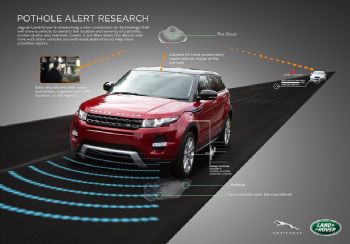
Jaguar Land Rover is developing technology that will allow a vehicle to identify the location and severity of potholes, broken drains and manhole covers and then share this data in real time (via the Cloud) with other vehicles and with road authorities to help them prioritise repairs.
Mike Bell, Global Connected Car Director at JLR, said: “If a car could receive warnings about potholes or broken manholes ahead, drivers would be able to slow down and avoid the danger — or the car could adjust its suspension settings to reduce the impact. This could help to reduce the potential for punctures, wheel and vehicle damage, and accidents.
“Our MagneRide-equipped Range Rover Evoque and Discovery Sport vehicles currently feature sensors that allow the vehicle to profile the road surface under the wheels and identify potholes, raised manholes and broken drain covers. By monitoring the motion of the vehicle and changes in the height of the suspension, the car is able to continuously adjust its suspension characteristics. We think there is a huge opportunity to turn the information from these sensors into ‘big data’ and share it with other road users.”
The next stage of the project at JLR’s Advanced Research Centre in Coventry is to install new road-surface-sensing technology in its Range Rover Evoque research vehicle, including an advanced forward-facing stereo digital camera. Mr Bell added: “At the moment, the most accurate data comes from when the car has driven over the pothole or manhole.We are researching how we could improve the measurement and accuracy of pothole detection by scanning the road ahead.
“In the future, we are looking to develop systems that could automatically guide a car around potholes without leaving its lane and causing a danger to other drivers. If the pothole hazard was significant enough, safety systems could slow or even stop the car to minimise the impact. This could all help to make autonomous driving a safe and enjoyable reality.”